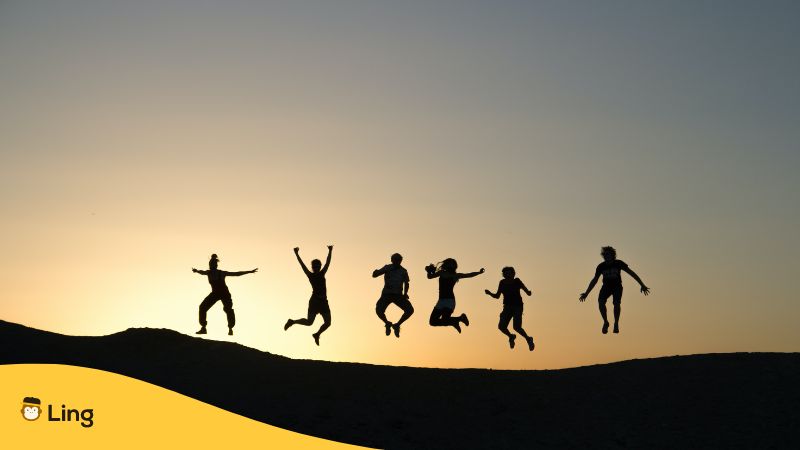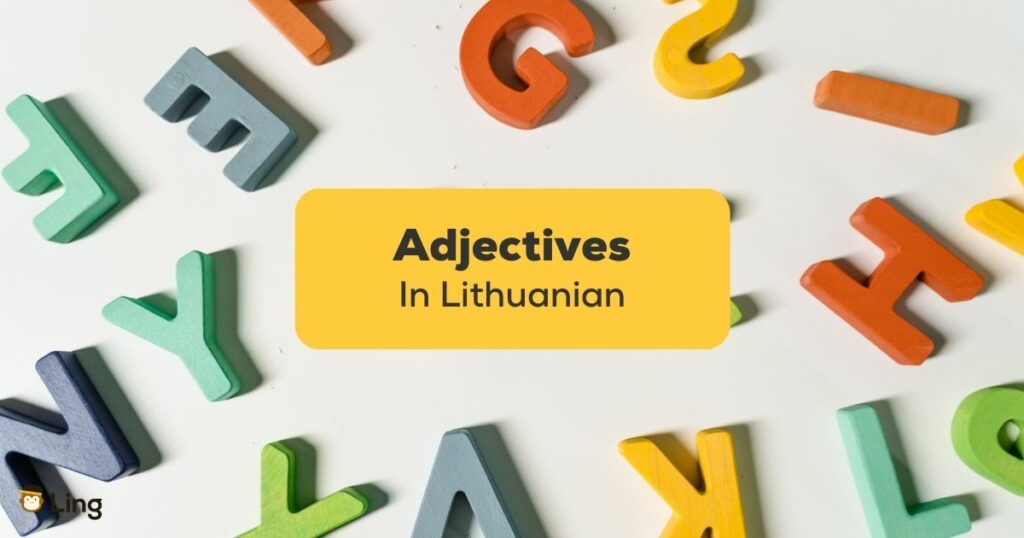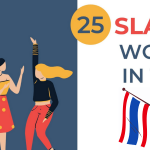Learning Lithuanian can be a challenging, yet entirely rewarding experience. Although there are only 2.3 million native Lithuanian speakers worldwide, it’s a language that is alive and well. If you have Lithuanian friends or a Lithuanian lover, then you know how important their mother tongue is to them! Here’s your chance to impress them and make an effort into learning their language and culture.
One aspect of the language that beginners often struggle with is understanding how Lithuanian adjectives work. In this blog post, we will explore Lithuanian with its adjectives, provide examples, and explain how they work in a sentence. Let’s break it down to be more understandable!
The Break Down Of Lithuanian Adjectives
In Lithuanian, adjectives can be a bit tricky, but with some practice, you’ll be able to use them with ease.
Let’s start with some examples of Lithuanian adjectives:
- Gražus (beautiful)
- Didelis (big)
- Geras (good)
- Šaltas – (cold)
- Naujas – (new)
Now, let’s take a look at how Lithuanian adjectives work in a sentence. Lithuanian adjectives have different forms based on 3 different genres: gender, number, and noun they’re describing. This can seem daunting at first, but don’t worry – we’ll break it down for you.
*One more thing to remember before we begin: Like with English adjectives, the adjective can go either before or after the Lithuanian noun that it’s describing.

How To Conjugate Lithuanian Adjectives In 3 Forms
#1 – Gender
Okay, you’re ready to learn about how to conjugate Lithuanian adjectives in the 3 different forms. Let’s start with gender.
In Lithuanian, nouns are either masculine, feminine, or neutral. Adjectives must agree in gender with the noun they describe. To make adjectives feminine, change the endings as follows:
masculine
-as -us -is
feminine
-a -i -ė
For example, if we wanted to say “the good man,” we would say “geras vyras,” ending with the adjective “geras” in the masculine form. If we wanted to say “the good woman,” we would say “gera moteris,” with the adjective “gera” in the feminine form. If we wanted to say “the good dog,” we would say “geras šuo,” with the adjective “geras” in the masculine form.
#2 – Number
Next, let’s look at number. Lithuanian nouns can be singular or plural, and adjectives must agree in number with the noun they describe. For example, if we wanted to say “the good book,” we would say “gera knyga,” with the adjective “gera” in the singular form. If we wanted to say “the good books,” we would say “geros knygos,” with the adjective “geros” in the plural form.
#3 – Case of Nouns
Finally, let’s talk about case. This is the most confusing part of Lithuanian adjectives, and what most language-learners struggle with.
In Lithuanian, nouns have different forms depending on their grammatical case. Adjectives must agree in case with the noun they describe. There are seven cases in Lithuanian, but it’s a more advanced level, so we will save those for another article.

Examples Of Lithuanian Adjectives & How They Change Forms In A Sentence
Gražus – Beautiful
- In Lithuanian, “gražus” is an adjective that describes something or someone as beautiful. Here are some examples of how it can be used in a sentence:
- Graži mergina – Beautiful girl
- Gražus vaizdas – Beautiful view
- Graži dovanėlė – Beautiful gift
Notice the following examples of how “gražus” changes depending on the gender and number of the noun it describes. In the first example, “gražus” becomes “graži” to agree with the feminine noun “mergina” (girl). In the second example, it becomes “gražus” to agree with the masculine noun “vaizdas” (view). And in the third example, it becomes “graži” again to agree with the feminine noun “dovanėlė” (gift).
Didelis – Big
- In Lithuanian, “didelis” is an adjective that describes something or someone as big. Here are some examples of how it can be used in a sentence:
- Didelis namas – Big house
- Didelė sala – Big island
- Dideli žaislai – Big toys
Just like “gražus,” “didelis” also changes depending on the gender and number of the noun it describes. In the second example, “didelis” becomes “didelė” to agree with the feminine noun “sala” (island). In the third example, it becomes “dideli” to agree with the plural noun “žaislai” (toys).
Geras – Good
- In Lithuanian, “geras” is an adjective that describes something or someone as good. Here are some examples of how it can be used in a sentence:
- Gera knyga – Good book
- Geri draugai – Good friends
- Geri maisto produktai – Good food products
Again, “geras” changes depending on the gender and number of the noun it describes. In the second example, it becomes “geri” to agree with the masculine plural noun “draugai” (friends). In the third example, it becomes “geri” again to agree with the masculine plural noun “maisto produktai” (food products).
Šaltas – Cold
- In Lithuanian, “šaltas” is an adjective that describes something or someone as cold. Here are some examples of how it can be used in a sentence:
- Šaltas vanduo – Cold water
- Šalti orai – Cold weather
- Šalta salotos – Cold salad
As you might have guessed, “šaltas” also changes depending on the gender and number of the noun it describes. In the third example, it becomes “šalta” to agree with the feminine noun “salotos” (salad).
Naujas – New
- In Lithuanian, “naujas” is an adjective that describes something or someone as new. Here are some examples of how it can be used in a sentence:
- Nauja knyga – New book
- Naujas automobilis – New car
- Nauji bateliai – New shoes
Again, “naujas” changes depending on the gender and number of the noun it describes. In the third example, it becomes “nauji” to agree with the masculine plural noun “bateliai” (shoes).
Whew, you made it through the trenches page of Lithuanian grammar! Good work! If you want rapid-fire examples of Lithuanian adjectives, they’re listed below. Time to get out the flash cards & memorize these stunning, colorful, huge adjective vocabulary words!
Rapid Fire Examples Of Lithuanian Adjectives

Colors
| English | Lithuanian |
| Colors | spalvos |
| Black | juoda |
| Blue | mėlyna |
| Brown | ruda |
| Gray | pilka |
| Green | žalia |
| Orange | apelsinas |
| Purple | violetinė |
| Red | raudona |
| White | balta |
| Yellow | geltona |
Sizes
| English | Lithuanian |
| Sizes | dydžiai |
| Big | didelis |
| Long | ilgas |
| Narrow | siauras |
| Short | trumpas |
| Small | mažas |
| Tall | aukštas |
| Thick | storas |
| Thin | plonas |
| Wide | platus |
Senses
| English | Lithuanian |
| Bitter | kartus |
| Fresh | šviežias |
| Salty | sūrus |
| Sour | rūgštus |
| Spicy | aštrus |
| Sweet | saldus |
Qualities
| English | Lithuanian |
| Bad | blogas |
| Clean | švarus |
| Dark | tamsus |
| Difficult | sunkus |
| Dirty | purvinas |
| Dry | sausas |
| Easy | lengvas |
| Expensive | brangus |
| Fast | greitas |
| Full | pilnas |
| Good | geras |
| Hard | sunkus |
| Inexpensive | nebrangus |
| Light | lengvas |
| New | naujas |
| Noisy | triukšmingas |
| Old | senas |
| Quiet | ramus |
| Slow | lėtas |
| Soft | minkštas |
| Young | jaunas |
Learn Lithuanian With Ling
Want more resources to help you learn Lithuanian? Download the Ling app today from the App Store and Play Store. It is a highly researched app meant for a fun and personalized language-learning experience. Aside from Lithuanian, there are over 60+ foreign languages to learn on Ling. Download it today!
Learn Lithuanian verbs and time and dates for more personalized Lithuanian practice!



































































